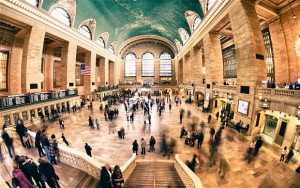It is likely that everyone has heard of the flight or fight mechanism, but is the same knowledge known about the incredulity response? What many claim to be the opposite of the fight or flight mechanism, the incredulity response was something that was brought to my attention in the reading. While floating through Grand Central Station, Mitchell encounters one of the most horrific sights in the novel. “The tunnel between the twin marble staircase was like a large greedy mouth drinking the water. But clogging that mouth and against the bottom of the stairs were bodies.” (173). Nathaniel Rich presents a very gruesome image that allows one to easily imagine and put to scale the amount of destruction that took place due to Hurricane Tammy. What really struck me about this passage wasn’t this image however, it is what Mitchell thinks to himself about the groups of people caught up in this catastrophe.
Incredulity is defined by Merriam Webster as a feeling that you do not or cannot believe that something is true or real. Mitchell gives a variety of examples of this incredulity response such as when “people who die in skydiving accidents are found to have never pulled the backup parachute” (174). This got me thinking about the different responses and initially I found a hard time understanding if this situation is truly applicable. It is our general instinct to survive and there are so many examples in literature and real life of the flight or fight mechanism. People suddenly getting the strength to lift a car off of an individual or running into a burning building like Mitchell does at Ticonderoga.
One of the most common examples of this response, is the cliche deer in the headlights. What I wanted to find however was a personal experience. In August of 2012, a mere two months before Superstorm Sandy hit New York I was in Florida with my family on vacation. During our vacation a hurricane started to materialize off the coast and many of the projections predicted that the hurricane would hit where we were. Having grown up in Oregon my whole life, I have been fortunate enough to never have experienced a natural disaster or catastrophe. For that reason I could not understand why my Dad was so worried. I had never been presented with a situation like this, he however had. My father grew up in Iowa and had experienced the destruction that could come with a tornado. Hurricane Isaac thankfully took an alternate course and hit Louisiana as opposed to Florida, After learning about this response and seeing how I reacted in the face of potential danger, I am fortunate that it didn’t hit. Below is a picture of Hurricane Isaac.
I think that this incredulity response doesn’t necessarily just describe catastrophic incidents, I think it can be tied to climate change as well. We have discussed at length in this class why don’t people care, and why don’t they do anything? Rich might be attempting to show that these three groups of people that Mitchell describes could symbolize the way in which groups of people react to the issue of climate change. There’s the first group of people, those who “raced up the stairs” (174), those who recognized the problem and decided to act. These people are like us, wanting to make a difference, acknowledging the problem and wanting to help combat it. Then there’s the second group of people, “naively hoping to be on the first train out” (174). This group of people acknowledges the problem, but thinks that nothing is going to occur to them. They believe they can sit idly by and hope the problem goes away, or someone else does something about it. Finally there is the incredulity, those who do not even believe that there is a problem. Those who have yet to experience the effects of climate change so they disregard it, claim that it isn’t a real problem. The more people who join group 1, the better off our environment will ultimately be. Hopefully novels like Odds Against Tomorrow steer people away from group 3 and more towards group 1 and 2 so that there is more action as opposed to skepticism.


I love how you pointed out the three groups of people who feel about climate change and compared this to the novel. This is a great example of how people react to something terrible, even if that something takes a long time to come to pass such as climate change. The first group have the greater chance of knowing how to combat that future and therefore probably have a greater chance to survive.
Your post addresses an an important issue that many people don’t take seriously, which is preparing for disaster. Many people simply don’t believe reports unless they see it for themselves, which of course is too late. If more people became aware of Climate Change’s effects, and the natural disasters that come with it, I’m sure more people would be prepared to deal with a catastrophic situation.
I really enjoyed reading your keen interpretation of Odds Against Tomorrow, and particularly how you interpreted certain aspects of the novel through the lens of allegory or symbolism. I wonder whether all cli-fi can be interpreted in one sense through an allegorical framework such as the one you develop here. That is, even if a novel or short story doesn’t explicitly mention “climate change” or “global warming” (as Rich never mentions either of these phrases in the novel Odds Against Tomorrow), perhaps climate change is always lurking in the background of the narrative and functioning as a force that requires us, as literary analysts, to interpret aspects of the plot as allegorical or symbolic commentary on climate change. Thanks for posting this and sparking this interesting discussion thread!